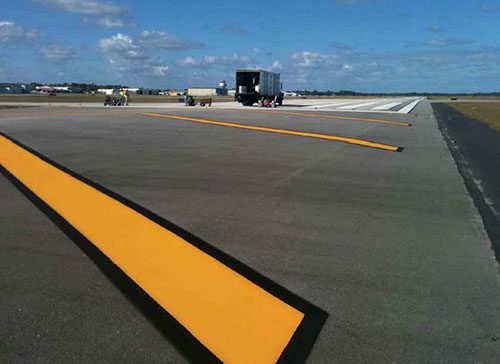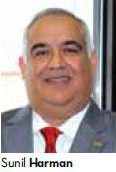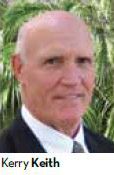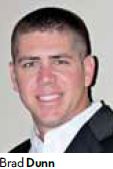 Most airport executives agree that dealing with governmental bureaucracy is the most frustrating aspect of their job. Between local, state and federal requirements, vital projects can take months, even years, to get approved, not to mention up and running.
Most airport executives agree that dealing with governmental bureaucracy is the most frustrating aspect of their job. Between local, state and federal requirements, vital projects can take months, even years, to get approved, not to mention up and running.
The state of Florida, however, is trying to change its part in the process. Three years ago, it launched a program designed to reduce the hassle of getting airport runways, taxiways and other airfield pavement repainted and remarked.
The program ran from early November 2010 through this April, and according to a sampling of the 23 participating airports, the Florida Statewide Runway Markings Contract was a big success.
In bureaucratic language, the program's mission was "to provide a cost-effective contracting method for Florida's public airports to maximize public investment in preserving aviation infrastructure." Bottom line: it saved budget-conscious airport managers time and money by providing pre-established pricing for standard painting and marking services from a vetted supplier.
|
factsfigures
Project: Florida Statewide Runway Markings Contract Purpose: Provide Florida airports with pre-established pricing and contract terms for runway/taxiway markings and maintenance Primary Vendor: Hi-Lite Markings Program Timeline: Nov. 2010 – April 2013 Participating Airports: Boca Raton, Crystal River, Daytona Int'l, Fernandina Beach, Fort Lauderdale-Hollywood Int'l, Hernando Co., Key West Int'l, Lauderdale Exec, Leesburg, Marathon Key, Naples Municipal, Northwest FL Regional, Ocala Int'l, Orlando Int'l, Pensacola Regional, Punta Gorda, St. Petersburg-Clearwater Int'l, Sebastian Municipal, Southwest FL Regional, Tallahassee Regional, Umatilla Municipal, Vero Beach Municipal, Zephyrhills Municipal Key Benefits: Airports saved time previously spent securing multiple competing bids and secured a pre-vetted vendor |
Hi-Lite Markings won the business over several vendors that responded to the state's request for proposals.
Although no definitive decision has been made to continue the program, it appears likely to be reinstated. "As long as Florida airport managers indicate the program has value, the department will continue to support the statewide effort," says Aaron Smith, state aviation manager for the Florida Department of Transportation Aviation Office.
Maintenance services covered by the contract spanned three main categories: surface preparation (including removal of existing paint, dirt, laitance and loose materials); painting of numbers, markings and stripes on runways, taxiways and aprons; and other miscellaneous maintenance.
Airport managers who used the program enjoyed fixed pricing for various services. Perhaps the biggest advantage was avoiding the time-consuming bidding process – the state had already completed that. In most cases, the process satisfied local budget committees with oversight over airfield maintenance and saved the airport considerable time and money.
Field Reports
The speed and efficiency of using a pre-negotiated contract made the Florida program a perfect fit for Vero Beach Municipal Airport (VRB), a general aviation facility with 160,000 to 165,000 operations per year. "We are very busy and need to have maintenance jobs such as runway markings done very quickly," explains Assistant Director Todd Scher.
"I took contract pricing from the state to the Vero Beach Purchasing Department, and they approved it relatively quickly. Without the state contract, we would have had to hire an engineering firm, then get bids. It would have required us to spend at least 50 percent more time to get this accomplished."
VRB was also pleased with the service it received from the state-selected vendor. "Hi-Lite Markings was a pleasure to work with and were very flexible on scheduling," notes Scher. "Their workmanship was second to none."
At VRB's request, Hi-Lite scheduled its work in December, when the airport is "slightly less busy." Using three separate trucks to reduce the total project time, Hi-Lite crews repainted its runway chevron markings in one day.
"One (truck) did yellow paints, the other did black outlines, and the third used roofing shingles to outline paint," recalls Scher.
"They worked sunup to sundown, which I appreciated."
With another runway in need of work this fall, VRB hopes the program is approved for continuation. "Overall, we had a very positive experience, and would definitely consider using the state contractor again, if the state reinstates this program," relates Scher.
Tallahassee Regional Airport (TLH), a facility that serves 680,000 passengers and handles 10,000 tons of cargo per year, also used the program – to clean its concrete apron and remark several sections of airfield pavement, including airport containment lines and enhanced hold position markings. American Airlines, Delta Air Lines, US Airways and Silver Airways are among the carriers that use its two runways.
Director of Aviation Sunil Harman estimates that using the state contract saved TLH 60 to 90 days when completing the projects. He also gives Hi-Lite high marks for addressing extra weather-related challenges that emerged during the work: "We had significant rains here in Tallahassee in the last few months, so we had a lot of mildew out in the airfield," he says. "They cleaned that up nicely."
Overall, Harman describes the state contract as "user friendly" and notes that it helped his airport a  great deal.
great deal.
The state program saved Naples Municipal (NPF) from having to secure three separate competitive bids when restriping its 5,800-foot primary runway, 5,000-foot crosswind runway and taxiways.
"It is not always timely to go out and find striping companies," explains Kerry Keith, NPF's director of airport development and facilities. "First, you have to meet with prospective vendors in person. Then you have to get them out into the field to see what is there. After that, you have to wait for the bids to come in and evaluate them. It can take several weeks. If we can piggyback on someone else who has done the work, that qualifies as getting a competitive bid."
Hi-Lite performed the airport's restriping and other runway marking projects in four days, completing work on the main runway in three to four hours to reduce downtime.
"The state contract was good for us," says Keith. "In early April this year, we had another vendor lined up to do some work, but that deal fell through, so we had to get a replacement within our timeframe."
Removing some of the uncertainties involved with contracting airfield pavement work was a big plus at Pensacola International (PNS). "With state contract pricing, you are likely to get a fair price with a respectable vendor," explains Dan Flynn, assistant director for operations. "We used Hi-Lite Markings for two years, for rubber removal and airfield painting services. They did a wonderful job. I have used them in the past for other projects as well. "
With about 110,000 operations per year and major airline service schedules to maintain, getting the work done in a timely manner was also crucial at PNS. "We do rubber removal on part of the airfield every year, and we have to constantly maintain our two main runways," reports Flynn.
 "Using the state contract cut down on the lead time considerably," he continues. "Going through the official bidding process for a given project makes it more difficult to keep a timetable. Here in Pensacola, if we don't have a state contract to use, we are required to get competitive bids from several vendors, which must be approved by the Pensacola City Council. Going through this process can add several months to a project."
"Using the state contract cut down on the lead time considerably," he continues. "Going through the official bidding process for a given project makes it more difficult to keep a timetable. Here in Pensacola, if we don't have a state contract to use, we are required to get competitive bids from several vendors, which must be approved by the Pensacola City Council. Going through this process can add several months to a project."
There also can be hidden costs associated accepting a low bid, cautions Flynn, citing rubber removal as an example. "The company with the lowest bid may not do the best work," he says. "If they use high-pressure removal (methods) and are not experienced in this type of work, they can damage the pavement, which will have to be fixed at extra cost."
as an example. "The company with the lowest bid may not do the best work," he says. "If they use high-pressure removal (methods) and are not experienced in this type of work, they can damage the pavement, which will have to be fixed at extra cost."
Provider Perspective
It took a great deal of planning on the state's part to implement the runway markings contract program, recalls Smith. "Due to the complex nature of the state procurement process, the original contract took more than two years from inception to execution," he explains, noting that the next contract should only take three to six months to advertise and execute
 "The project was the genesis of the Continuing Florida Aviation System Planning Process (CFASPP) committees," he continues. "The CFASPP is a method used within Florida to continually monitor the aviation environment and determine the development requirements to best meet projected aviation demands."
"The project was the genesis of the Continuing Florida Aviation System Planning Process (CFASPP) committees," he continues. "The CFASPP is a method used within Florida to continually monitor the aviation environment and determine the development requirements to best meet projected aviation demands."
The process, he adds, is a component of the FAA Continuous Airport Systems Planning Process.
From Hi-Lite's point of view, bidding a contract for a program with nearly 130 eligible airports was a bit tricky, relates Brad Dunn, the company's Southeast division manager who oversaw the Florida program. A tiered pricing schedule provided graduated costs for various sized projects – airports with less than 5,000 square feet of work, 5,000 to 20,000 square feet, and more than 20,000 square feet.
"That evened the playing field," relates Dunn. "Not all jobs are equal, but the state contract did a good job of qualifying bids."
Hi-Lite's nationwide staff of 120 workers helped service the new business. "If we had a big job in Florida, we had the manpower to do it on schedule," says Dunn, who is convinced that his company has proven itself to the state and its airports.

"After spending the last few years talking to our clients, I think all of them appreciated the fact that we saved them time, money and hassle, and did quality work," he explains. "But I think one of the best benefits we offered was that airport executives could plan ahead and budget several years in advance with set pricing. That was good for their airport and for them."

Working under the state contract kept the company consistently busy for the last 21/2 years, he reports. "For us, it was well worth it. I know we would do this again if the state decides to reinstate the program later this year," he says.



